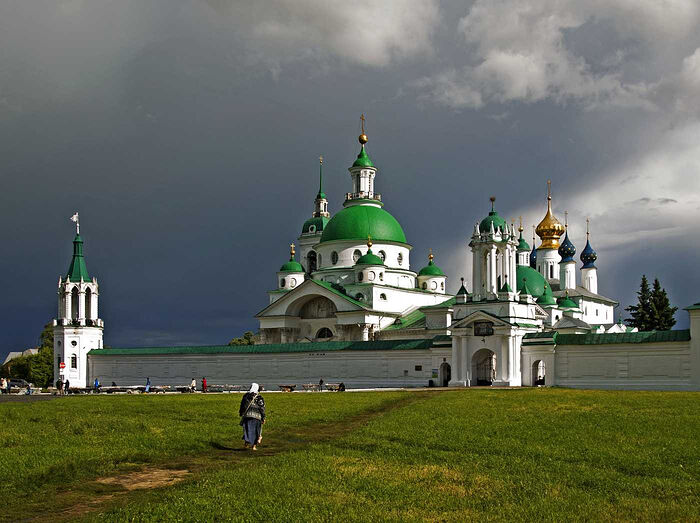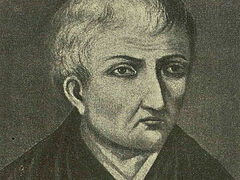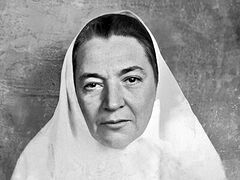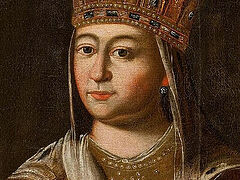Sell that ye have, and give alms;
provide yourselves bags
which wax not old, a treasure
in the heavens that faileth not,
where no thief approacheth,
neither moth corrupteth.
Luke 12:33
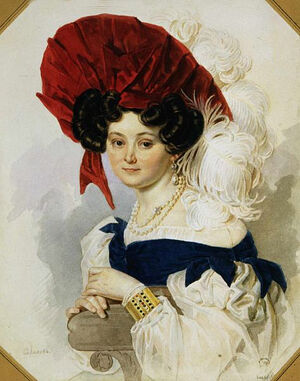 Countess Anna Alexeyevna Orlova-Chesmenskaya. Watercolor. P.F. Sokolov, 1830s Countess Anna Alexeyevna Orlova-Chesmenskaya was born in Moscow on May 2, 1785 to the family of general-in-chief Alexey Grigorievich Orlov (1737–1807), a companion of Empress Catherine II. Count Orlov became famous for his remarkable victory in the Battle at Chesma with the Turks, for which he received an addition to his last name—Chesmensky. But apart from his heroic deeds, he also committed crimes in his life: During the coup of 1762, he took part in the murder of Emperor Peter III and played a disreputable role in the kidnapping of Princess Tarakanova.
Countess Anna Alexeyevna Orlova-Chesmenskaya. Watercolor. P.F. Sokolov, 1830s Countess Anna Alexeyevna Orlova-Chesmenskaya was born in Moscow on May 2, 1785 to the family of general-in-chief Alexey Grigorievich Orlov (1737–1807), a companion of Empress Catherine II. Count Orlov became famous for his remarkable victory in the Battle at Chesma with the Turks, for which he received an addition to his last name—Chesmensky. But apart from his heroic deeds, he also committed crimes in his life: During the coup of 1762, he took part in the murder of Emperor Peter III and played a disreputable role in the kidnapping of Princess Tarakanova.
In 1782, Count Orlov-Chesmensky married Eudoxia Nikolaevna Lopukhina (1761–1786), who bore him a daughter, named Anna at baptism. A year and a half later, Eudoxia died in childbirth, and her son Ivan died a year later. Anna became the only heiress of her father’s vast fortune. Gruff by nature, Count Orlov was fond of his favorite daughter. He settled in his estate near Moscow called Otrada and focused all his attention on the upbringing and education of Anna, hiring the best available tutors for her schooling. By the age of seven, she already knew French, German, English and Italian, learned the Catechism and arithmetic. She also learned the art of dance and how to ride. The count built a special palace for her with its own park, where they organized masquerades, fireworks, and performances. In 1796, her father took Anna to St. Petersburg, where he presented her to Empress Catherine, who, according to an eyewitness, said: “This girl promises many good things.” Her words proved prophetic. She was also granted the title of maid of honor of the Imperial Court.
Anna became the sole heiress to her father’s vast fortune
After the death of Empress Catherine II, the Orlovs, fearing the wrath of the new Tsar Paul I, went to Dresden, but at the accession of Alexander I they returned to Russia and settled in the Alexandriysky Palace near Donskoy Monastery. Sixteen-year-old Countess Anna began to go out. G.R. Derzhavin, having seen her at a ball in 1801, dedicated poems to her praising the rising star that appeared on the Moscow horizon. Many eligible bachelors—aristocrats, including the Princes Golitsyn, Prince Alexander Kurakin, a famous man of wealth and nobleman, and Prince Platon Zubov, the last favorite of the Empress, sought her hand in marriage. Moscow’s town governor F.V. Rostopchin wrote in 1807: “Orlov’s house is filled to the brim with his daughter’s suitors…” However, all the suitors were rejected by either Anna or her father. Only Count N.M. Kamensky won Anna over, but soon she got disappointed even in him. Anna also felt suspicious of her suitors later in life, believing that they were attracted exclusively to her wealth.
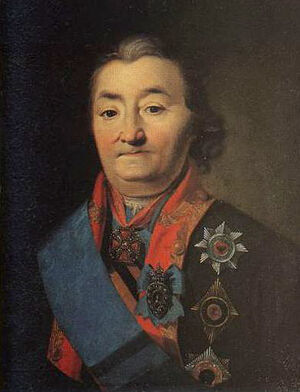 Alexey Orlov in his later years On December 24, 1808, Count Alexey Grigorievich Orlov died at age seventy-two. Shocked by the death of her beloved father, Anna fainted and remained without signs of life for fourteen hours. When she came back to her senses, she announced before the icon of the Savior: “Lord! Be as my mother and father and guide me throughout all the deeds of my life.” Having inherited untold wealth, including mansions, lands, stud farms and money capital, she decided to spend her money on monasteries and churches—to be rich toward God. Already a year after her father’s death, in 1809, Anna erected the Church of the Protection of the Most Holy Mother of God in her own village of Pady in Voronezh province. Overall, she paid for the construction of fifteen churches in that province. She provided money and weapons for the zemstvo volunteer forces in Voronezh.
Alexey Orlov in his later years On December 24, 1808, Count Alexey Grigorievich Orlov died at age seventy-two. Shocked by the death of her beloved father, Anna fainted and remained without signs of life for fourteen hours. When she came back to her senses, she announced before the icon of the Savior: “Lord! Be as my mother and father and guide me throughout all the deeds of my life.” Having inherited untold wealth, including mansions, lands, stud farms and money capital, she decided to spend her money on monasteries and churches—to be rich toward God. Already a year after her father’s death, in 1809, Anna erected the Church of the Protection of the Most Holy Mother of God in her own village of Pady in Voronezh province. Overall, she paid for the construction of fifteen churches in that province. She provided money and weapons for the zemstvo volunteer forces in Voronezh.
After the death of Count Orlov, ill-wishers told Anna about his ignoble deeds and she almost lost her mind. In search of consolation, she went on a pilgrimage to the Kiev Caves Lavra, where she funded the opening of a free canteen for needy elderly people. From Kiev, she traveled to Rostov to venerate the relics of St. Demetrius of Rostov. Here, in the Savior-St. James monastery, she met the elder Hieromonk Amphilochius, and, after speaking with him, she “realized she had become indifferent to worldly happiness,” having understood the vanity of genteel pastimes. Thus a new life began for Countess Anna Alekseevna, replete with self-denial, piety and vigorous charity work. She became the elder’s spiritual daughter, and came to see him in his monastery every year during Lent, to pray and celebrate Pascha there. She exchanged letters with Hieromonk Amphilochius until his death in 1824. Anna started to give alms to the Savior-St. James monastery and never stopped her donations even after her spiritual father’s death. All in all, she contributed about three hundred thousand rubles to the monastery—a massive amount for those times. With her funds, a stone church to St. James of Rostov was erected, along with the silver shrine that was installed over the relics of St. James. In the 1840s, she contributed funds to renew the painting in the Conception of St. Anna’s Church and the making of a silver cover for its altar table. She also repeatedly made donations to the monastery by purchasing vestments, icon frames, richly decorated service books, etc.
Throngs of the poor and beggars flocked to her house every day, and no one left without receiving help
Crowds of the poor and beggars flocked to her house every day, and no one left without receiving help. She became a generous contributor to the Moscow people’s volunteer corps in the Patriotic War of 1812. She donated one hundred thousand rubles, four thousand three hundred rifles, four thousand spades, three hundred bayonets, four thousand helmets, forty pood1 of lead, twenty pood of gunpowder, and one hundred sixty thousand flints for the organization of the people’s volunteer corps. How great was her assistance to the Russian army by way of supplying it with a huge amount of provisions!
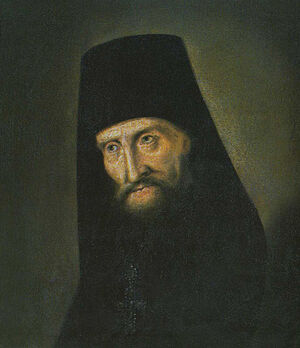 Elder Amphilochius (unknown artist of the beginning of the 19th century) Being genuinely religious, yet keeping it secret from the outside world, Anna never abandoned the Imperial court, and it heaped her with favors. In 1817, she was granted the title of a chamber maid, while the Empress Elizabeth Alexeyevna presented her with her portrait. During the coronation of Nicholas I, a ribbon of the Order of St. Catherine, smaller cross, was laid over her shoulders. She accompanied Empress Alexandra Fyodorovna, the wife of Nicholas I, on her journey across Russia and Europe. The Countess continued to hold luxurious social functions greatly admired by high society.
Elder Amphilochius (unknown artist of the beginning of the 19th century) Being genuinely religious, yet keeping it secret from the outside world, Anna never abandoned the Imperial court, and it heaped her with favors. In 1817, she was granted the title of a chamber maid, while the Empress Elizabeth Alexeyevna presented her with her portrait. During the coronation of Nicholas I, a ribbon of the Order of St. Catherine, smaller cross, was laid over her shoulders. She accompanied Empress Alexandra Fyodorovna, the wife of Nicholas I, on her journey across Russia and Europe. The Countess continued to hold luxurious social functions greatly admired by high society.
In view of Elder Amphilochius’s serious illness (he lost the use of his legs), Anna Alekseyevna had to look for a new father confessor. Bishop Innocent (Smirnov) of Penza and Saratov, presently glorified by the Russian Orthodox Church among the saints, recommended his disciple Photius (Spassky; 1792–1838) to her. A little-known monk from the Alexander Nevsky Lavra at the time, he was destined to play an important role in Anna’s life.
Archimandrite Photius went down in the history of the Russian Church as a prominent public figure, theologian, man of faith, ascetic, and fearless accuser of the vices that prevailed in society. Illness prevented him from graduating from the St. Petersburg Theological Academy he had entered in 1814. Perceiving his profound faith, Archbishop Innocent, the rector of the Theological Seminary, took kindly to him and offered board and lodging at his house. In 1817, he was tonsured a monk with the name of Photius and later ordained a hieromonk. In 1818, he became a cathedral Hieromonk of the St. Alexander Nevsky Lavra. Leaving for Penza in 1819, Vladyka Innocent recommended his disciple Photius to his disciples in St. Petersburg as an opponent of the Freemasonry and mystical sentiments that prevailed in society at the time. Monk Photius fearlessly fought against Freemasonry without regard for its representatives among the influential power players of the empire. Physically weak, in fetters and haircloth, his body full of festering wounds, Photius still had a willing spirit (cf. Matthew 26:41), ardent faith and iron will. A valorous warrior of Christ, he devoted his life to the fight for the purity of Orthodoxy.
Anna’s first meeting with the monk Photius took place on May 2, 1820. The day before, she listened to his fiery sermon in the St. Petersburg’s Kazan Cathedral, where he passionately denounced the vices and plagues of high society. The monk’s speech made a strong impression on her. Anna wrote of Photius:
“He aroused my attention by the courage and fearlessness he demonstrated when he denounced the prevailing misbeliefs about faith. Everyone was against him, beginning with the Court. He rose to the challenge. I wanted to learn more about him and entered into correspondence with him. His letters sounded to me like the Apostolic Epistles. As I got to know him better, I became convinced that he did not seek any personal gain for himself.”
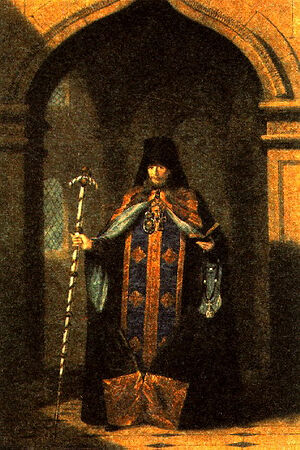 Archimandrite Photius (Henry Dow from the engraving of George Dow, 1822–1824) In 1820, Hieromonk Photius was exiled from St. Petersburg for his vigorous political activity and appointed abbot of the dilapidated Derevyanitsky monastery near Novgorod. Anna Orlova immediately donated large funds for the restoration of the monastery: She sent Photius three thousand rubles “for his personal needs” and later another ten thousand plus two wagon trains—one of them carried candles, incense and wine, and in another was bread. In January of 1822, under the influence of Countess Orlova, Metropolitan Seraphim (Glagolevsky) of St. Petersburg elevated Photius to the rank of archimandrite and transferred him to the dilapidated Skovorodsky monastery, which Photius, at the expense of Anna Orlova, restored in six months. Soon, thanks to Anna Alexeyevna’s connections, Photius was appointed abbot of the Svyato-Yuryev (St. George) Monastery in Novgorod, which was also in a deplorable state. During the same year, on the advice of Metropolitan Seraphim, Countess Anna became the spiritual daughter of Archimandrite Photius and followed him to Novgorod. In 1828, she bought a small estate with a stone house near the monastery and moved there from St. Petersburg for permanent residence.
Archimandrite Photius (Henry Dow from the engraving of George Dow, 1822–1824) In 1820, Hieromonk Photius was exiled from St. Petersburg for his vigorous political activity and appointed abbot of the dilapidated Derevyanitsky monastery near Novgorod. Anna Orlova immediately donated large funds for the restoration of the monastery: She sent Photius three thousand rubles “for his personal needs” and later another ten thousand plus two wagon trains—one of them carried candles, incense and wine, and in another was bread. In January of 1822, under the influence of Countess Orlova, Metropolitan Seraphim (Glagolevsky) of St. Petersburg elevated Photius to the rank of archimandrite and transferred him to the dilapidated Skovorodsky monastery, which Photius, at the expense of Anna Orlova, restored in six months. Soon, thanks to Anna Alexeyevna’s connections, Photius was appointed abbot of the Svyato-Yuryev (St. George) Monastery in Novgorod, which was also in a deplorable state. During the same year, on the advice of Metropolitan Seraphim, Countess Anna became the spiritual daughter of Archimandrite Photius and followed him to Novgorod. In 1828, she bought a small estate with a stone house near the monastery and moved there from St. Petersburg for permanent residence.
Her donations flowed to Yuryev Monastery like a wild river: golden and silver items of high artistic merit, diamonds and sapphires, pearls and emeralds. By Orlova’s order, trains of wagons carrying food arrived at the monastery. Thanks to the generous donations of Anna Alexeyevna, Archimandrite Photius restored the ancient Yuryev Monastery over a short period of time.
The restoration of old churches and the construction of new ones in the monastery was funded by Countess’s donations, including the All Saints Church, the Savior Cathedral, the Church of the Exaltation of the Cross, the east-facing building with cells for the brethren, and the south-facing building with the hospital’s home church to “The Unburnt Bush” Icon. In 1841, the bell tower was built according to the blueprints of architect Carl Rossi. When a fire destroyed the Cathedral of the Exaltation of the Holy Cross in 1823, the Orthodox countess immediately forwarded forty thousand rubles worth of materials for its reconstruction.
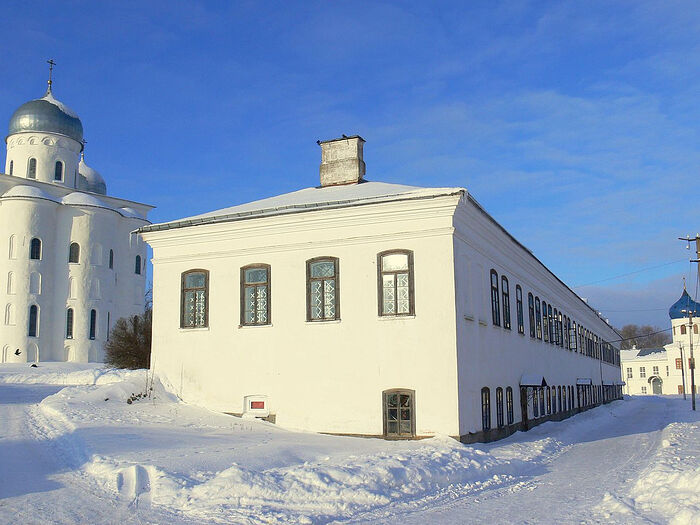 Orlovsky building and St. George Cathedral of the Yuriev monastery
Orlovsky building and St. George Cathedral of the Yuriev monastery
Countess Orlova’s philanthropy was not limited strictly to the Yuryev Monastery. Her funds helped to maintain the St. Sophia Cathedral and other monasteries in Novgorod. In 1816–1822, in her inherited estate in the village of Mikhailovskoye near Moscow, the pious countess built a stone church in honor of Archangel Michael with side chapels to Holy Hierarch Nicholas and the Holy Myrrh-bearing Women, the latter consecrated in 1824. This magnificent church in the vicinity of Domodedovo is a joy to see even today—especially its unique iconostasis. In 1842, Anna Orlova donated a silver shrine to the Holy Trinity Church of the Pochaev Lavra to hold the incorruptible relics of St. Job of Pochaev, and ornate decorations of the elevated place around the miracle-working icon.
Anna led a strict, practically monastic lifestyle, repenting unceasingly and seeking forgiveness for her father’s sins
In 1831, Anna moved the remains of her father and his brothers from the estate near Moscow to the Yuryev Monastery, reburying them under the porch of St. George’s Cathedral. Archimandrite Photius “guided her to leading life as a maiden, in physical and spiritual chastity.” He remained strict with his spiritual daughter to the end of his life, denouncing the luxury and excesses in her life. He blamed her even for the most minor offenses and often said, “Don’t pride yourself on your wealth, as it was obtained through sin, as ill-gotten gains.” Anna led a strict, almost monastic lifestyle, repenting unceasingly and praying for forgiveness for her father’s sins, as if she carried the heavy burden of all of Count Orlov’s former life on her own shoulders.
In her correspondence, she called herself “wretched Anna.” One day, Anna began a conversation about a possible marriage. Photius then took her to the icon of Jesus Christ, hung her ring on top of it and said: “Behold your bridegroom!” After this, the Countess took a vow of celibacy.
On February 26, 1838, Archimandrite Photius died in the arms of his spiritual daughter. Following his death, Anna spent the last ten years of her life next to the Yuryev Monastery. She diligently attended services at the Church of the Laudation of the Mother of God, where a litya was served daily, while on Saturdays, a Pannikhida was served for her parents and spiritual father. After her pilgrimage to Kiev, she made a number of large contributions: She ordered a new bronze iconostasis worth one million rubles to be made for the Dormition Cathedral of the Kiev Caves Lavra. In the St. Michael’s Monastery, she ordered a silver shrine and a canopy weighing about four hundred kilograms for the relics of the Great Martyr Barbara. Besides that, in 1840 alone Anna allocated over fifty thousand rubles in silver for the needs of the Kiev Caves Lavra. Anna Alexeyevna sent lavish gifts abroad as well. The patriarchal churches of Constantinople, Alexandria and Damascus were adorned using her money, and her donations were sent to Jerusalem and the Athonite monasteries. Overall, during her lifetime, Anna Orlova spent about twenty five million rubles on various churches and monasteries. Therefore, the Countess spent her inheritance on charity, becoming like the Venerable Melania of Rome (385–439 AD), who generously gave money to the needy.
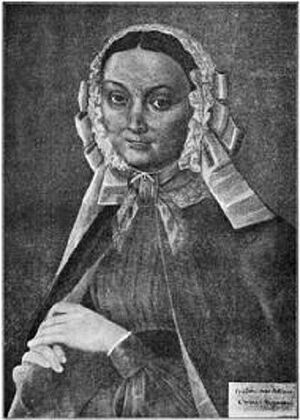 Countess Anna Orlova (engraving by L.A. Seriakov, 1870s) As one of the largest landowners of the Russian Empire, Anna Alexeyevna tried to improve the lot of her peasants. She turned some of them into free grain farmers and moved others to the authority of Appanage Department, since the peasants under its authority enjoyed a more secure life. She preached salvation among her serfs, predominantly the pagan Chuvash peasants in her Samara Province estates, and achieved the conversion of many of them to Christianity. The countess built for them a stone church in the village of Lower Ivanovka.
Countess Anna Orlova (engraving by L.A. Seriakov, 1870s) As one of the largest landowners of the Russian Empire, Anna Alexeyevna tried to improve the lot of her peasants. She turned some of them into free grain farmers and moved others to the authority of Appanage Department, since the peasants under its authority enjoyed a more secure life. She preached salvation among her serfs, predominantly the pagan Chuvash peasants in her Samara Province estates, and achieved the conversion of many of them to Christianity. The countess built for them a stone church in the village of Lower Ivanovka.
Anna Orlova died unexpectedly on October 5, 1848. She was buried in a tomb prepared in advance in the Church of the Laudation of the Most Holy Mother of God, next to the tomb of Archimandrite Photius.
After the countess died, a Gospel was found in her belongings inscribed by the Kiev elder Parthenius, whom she greatly revered. The inscription was written in 1845, where he calls Anna, “sister in Christ EINGA”. Apparently, Anna Orlova secretly took the monastic tonsure with the name Agnia (EINGA—or Agnia spelled backward in the vocative case). According to pre-revolutionary testimonies, miracles of healing were recorded on her grave.
Anna Alexseyevna Orlova bequeathed large sums to the monasteries: three hundred thousand rubles to the Yuryev Monastery, thirty thousand to Pochaev Lavra, ten thousand to Solovki Monastery, one million seven hundred thousand to three hundred and forty different monasteries (five thousand each), one hundred forty four thousand to forty eight cathedrals, and two hundred ninety four thousand to diocesan trustee departments. The jewels owned by the Countess were also used for charitable purposes. According to her will, Anna Alexseyevna’s relatives received nothing but the steppe lands in Voronezh province.
In gratitude for the donations she made to benefit the churches and monasteries, the Countess was honored with an honorable commemoration there: She was commemorated daily as their benefactor at the Liturgy, and following the conciliar remembrance prayers in the cathedrals, a meal was offered to the beggars in her memory. Countess Orlova’s charity was also appreciated by her contemporaries. For example, Prince Platon Shirinsky-Shakhmatov wrote soon after her death, “She never forgot even the least of the brothers in Christ who sought help.”
In 1932, the Bolsheviks opened up the gravesites of Archimandrite Photius and Anna Orlova and had their remains scattered throughout the crypt. The faithful transferred their remains to the Novgorod’s Annunciation Church in Arkazhy. The exact place of burial is currently unknown. In 2001, a symbolic grave with a cross was arranged near the apse of the church.
The words spoken by the Lord, How hardly shall they that have riches enter into the kingdom of God! (Mark 10:23) do not apply to philanthropists such as Countess Anna. The monasteries and churches preserved and built at her expense testify to the enduring value of the spiritual labors of this remarkable woman, Anna Alexeyevna Orlova-Chesmenskaya, whose life remains an example for all the Russian wealthy people who live in our time.

